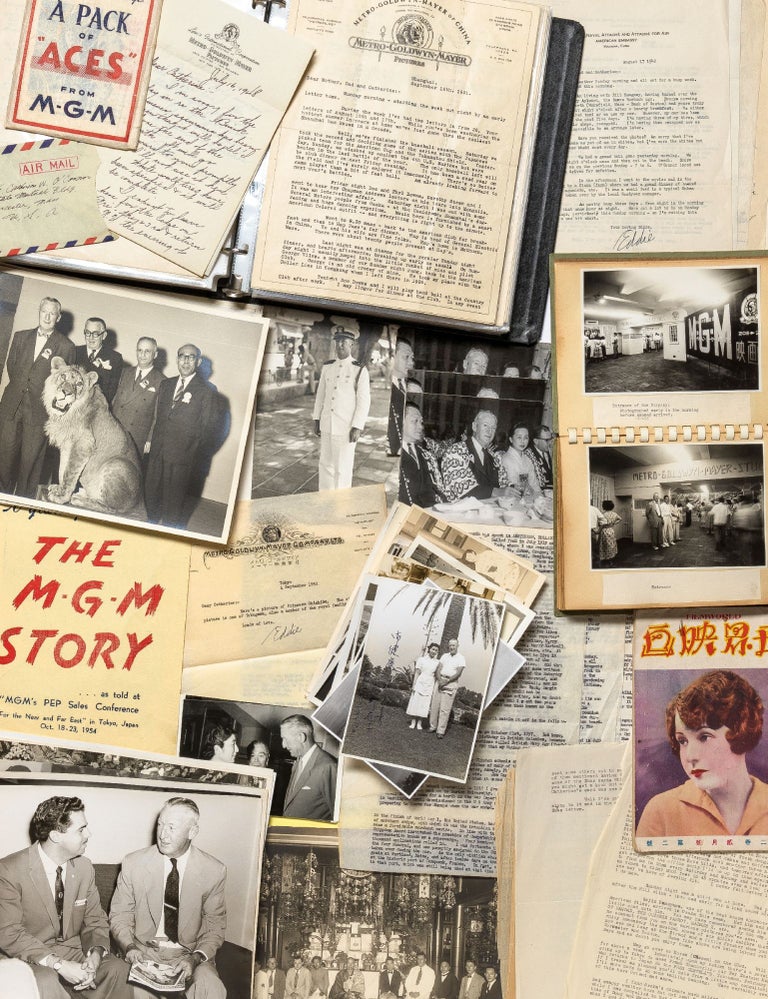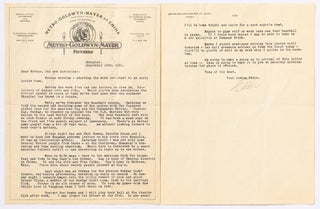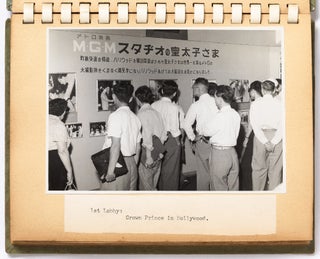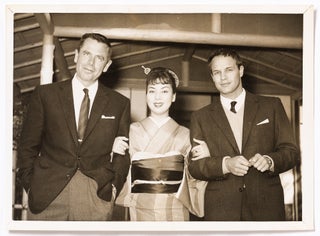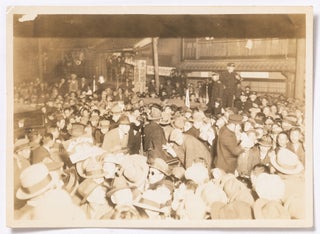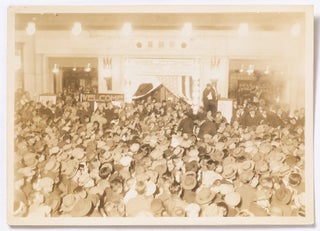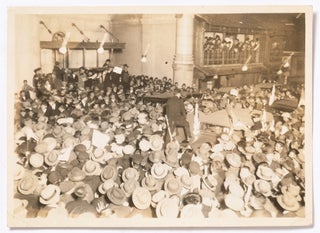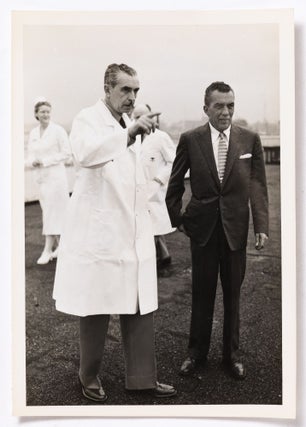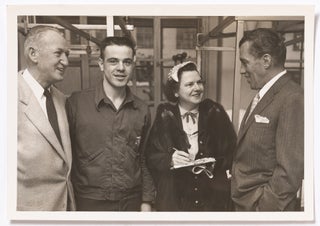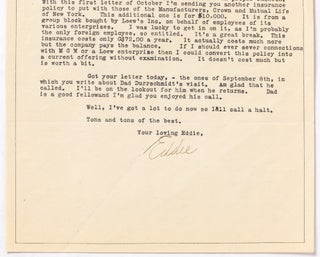(Japan; China; Indochina; Cuba): (1919-1957).
Price: $9,600.00
An archive of over 100 letters and well over 200 photographs belonging to Edward “Eddie” Francis O’Connor, a World War II U.S. Navy Commander and a leading MGM executive who, spanning a 30 year period from 1926 through 1957 opened and managed MGM Studio headquarters and offices in Japan, China, India, Indochina, and later in Cuba. Throughout his long and distinguished career, O’Connor maintained close working and personal friendships with theater magnate Arthur Loew (who created MGM), American film director Clarence Brown (MGM’s leading director), and Jean Marie Faircloth (Douglas MacArthur’s famous wife), whom O’Connor first met at the “American Mess” in Singapore. Among the photographs are numerous images of O'Connor with famous actors and actresses, including Mary Pickford, Douglas Fairbanks, Spencer Tracy, Machiko Ky , Marlon Brando, and Glenn Ford (to name but a few); and prominent political leaders and dignitaries, including Jawaharlal Nehru and Crown Prince Akihito (the present Emperor of Japan).
Born in Massachusetts in 1897, O’Connor first served as a super cargo (overseer) for the U.S. Shipping Board in the Far East, and later as an agent for the Pacific Mail Steamship Company based in Hong Kong. In 1926 he went to Japan to head the distribution of American motion pictures for First National Pictures (predecessor to Warners). Two years later he met Arthur Loew and joined MGM, and was sent to India to open MGM headquarters in Bombay and offices in Calcutta and Delhi. This annual pattern of continual travel (mostly throughout the Far East) with about two months each year at MGM’s New York offices and occasional trips to MGM’s Hollywood headquarters, held throughout O’Connor’s career. He was sent back to Japan in 1929, and from 1930-33 he headed the MGM office in Shanghai, China: “We had a lot of trouble in Shanghai in those thrilling days … we had two stirring invasions … one was by Chinese warlords from the North and the second and most serious was when the Japanese bombed the North Station in Shanghai and took over Kangwon.”
From 1933-37 he managed MGM operations in Malaya, Indonesia, Siam and Indochina (with headquarters in Singapore), and then went back briefly to Japan to take over operations in Japan and Manchuria: “This was about the time the Japanese were getting cantankerous. Twelve of us, were given rough treatment, and I left Japan and went over to Shanghai.” After he was expelled from Japan he went to his new post in Havana, Cuba: “Lived and loved Cuba and the Cubanos until Day of Pearl Harbor.” O’Connor immediately went into service as a Lieutenant in the U.S. Navy and was assigned an Assistant Naval Attache at the American Embassy in Havana. Accordingly, his first two years of war service were in the Caribbean, until being transferred to the China-India-Burma Theatre in 1944, where he was promoted to Commander. After the war O’Connor rejoined MGM as supervisor for the Far East until 1950 when he received permission from General MacArthur to reopen MGM operations in occupied Japan. He remained in Japan until 1956, whereupon he returned to Havana, Cuba.
The collection consists of well over 200 black & white photographs, most of which were taken in Japan and Indochina before and after World War II, and including about 20 photographs taken in Cuba from the late 1930s through early 1940s. Among the over 100 letters in the collection, most were written by O’Connor to this family in Clinton, Massachusetts. Also included are Asian film magazines, MGM promotional ephemera, newspaper and magazine clippings, and a few of O’Conner’s personal documents. Scattered short tears and associated creasing to the edges of some photographs and magazines, else most items in the archive are near fine or better.
Among the collection’s highlights are numerous photographs of O’Connor meeting with MGM stars and other leading actors and actresses. There are also several notable photographs of O’Connor conducting Japanese Crown Prince Akihito through the MGM Hollywood studios and presenting him to the stars and directors; and of O’Connor escorting Ed and Sylvia Sullivan as guests in Japan on the set of the *Teahouse of the August Moon* in April, 1956. Also on the *Teahouse* set and elsewhere in Tokyo are several outstanding images of the film’s starring actors: Machiko Ky , Marlon Brando, and Glenn Ford.
Included among O’Connor’s letters is a long and detailed description of the December 1929 visit of Douglas Fairbanks and Mary Pickford to Japan: “one of the most hectic weeks in history” – “Mary and Doug arrived on Monday evening aboard the SS Asama Maru at Kobe … there were ten thousand people on the dock … Policemen were helpless. I was the only individual in the crowd that was permitted up the gangway … when we finally got them into a car thousands of crazed movie fans hung to the car, broke its windows and almost suffocated the celebes … .” Accompanying the letter are three 5" x 7" black & white photographs of their arrival: “In front of Shochikuza Osaka, December 16th – Was in this car with Douglas and Mary,” and one 8" x 10" photograph of Fairbanks and Pickford at an event hosted by the national newspaper *Asahi Shimbun* at the Asahi auditorium in Osaka.
An historically important and very interesting assemblage of materials, documenting MGM’s early glory days in the Far East. A more detailed list of selected items in the collection follows:
Early Letters (1919-c.1925)
-3 Autograph Post Cards (1919); 1 Real Photo autograph Post Card (Japan, c. 1925).
-ALS. 4pp. Small quarto. Unites States Shipping Board, Washington: August 27, 1919. Charlie Hayes to Thomas O’Conner (Eddie’s brother), re: Eddie’s apprenticeship in the “steamship game”.
Pre-World War II period (December 1926 – December 1941)
About 100 letters written from: Japan, China, India, Indochina, and Cuba.
Housed in plastic sleeves in three-ring binder: Most are TLS on studio letterhead sheets (First National Pictures and MGM); most consisting of two or three pages each. Some letters have accompanying ephemera, for example:
-[Mimeograph broadsheet]: “Base Ball … World Series of Bombay.” O’Connor is listed as Captain of the team “Yankees” (December 7, 1928).
-[Newspaper clipping]: *The China Press Sporting Pink*, Shanghai, July 12, 1931. “Marines Defeat Amateurs in July Fourth Classic, 3-2.”
Letters from Cuba (1942-44)
Five letters (TLS). Three from Eddie, Office of Naval Attaché and Attaché for Air American Embassy, Havana, Cuba (to Mother, Dad, and Catherine), two to Eddie (one in Spanish. 1942-44. + one document: Farewell tribute to O’Conner, with 34 autograph signatures.
Selected Excerpts from the Letters
Enroute Maymyo, Burma: April 22, 1929
“… Here we are actually “On the Road to Mandalay” … / We’re putting on a special big show with the COSSACKS – John Gilbert, Renee Adoree – a rattling fine film. We’re going to invite the Governor of Burma and the General Commanding British troops in this territory to a big preview. We going to put on a big special show that will give Maymyo something to talk about and put a few sheckels in our own coffers.” [Directed by Clarence Brown].
Tokyo, September 6, 1929
“ … There’s a great deal to do in connection with taking over this old United Artists establishment and taking over their pictures, advertising accessories, their staff, office equipment … It’s no joke …”
Tokyo, September 15, 1929
“… I’m a little stiff from playing baseball yesterday … Our Metro-Goldwyn-Mayer office team is playing Paramount this afternoon and the boys have asked me to pitch for them … The Japanese sure love their baseball. Everywhere you go today you’ll find baseball in the air … Kids knee high to a grasshopper to me of forty are gracing the sandlots all over this county tossing the pill about and banging them all over the lots. No Japanese team plays as we used to when kids – without uniform. They’re all equip- here. Our office team has snappy looking uniforms – I’ll probably be the only man out of order – without a uniform. … / … [we] journeyed out to Asakasuka Park and put on BROADWAY MELODY after the theaters had let out. We have a private preview that was a knock-out. This picture is one that you should see …”
[Tokyo] November 3rd, 1929 (Sh chiku Motion Picture Company)
“… am now all set with the boys in the office to take a quick trip down to Kawasaki where M G M has a ball game all set with the Kamata Studio boys of the Shochiku Motion Picture Co., the largest Japanese producing company. All the well-known Japanese actors and actresses will be amongst those present today and will get a great kick out of seeing a foreigner lined up with the Japanese playing baseball.”
Osaka, December 21st, 1929
Describes in detail “one of the most hectic weeks in history” receiving “Mary and Doug”.
(During December 1929 the visit of Douglas Fairbanks and Mary Pickford to Japan was marked by scenes of extraordinary enthusiasm with Japanese admirers frantically mobbing the cinema stars wherever they went. They departed Japan on the Asama Maru on December 21st.)
“Mary and Doug arrived on Monday evening aboard the SS Asama Maru at Kobe … there were ten thousand people on the dock … Policemen were helpless. I was the only individual in the crowd that was permitted up the gangway … when we finally got them into a car thousands of crazed movie fans hung to the car, broke its windows and almost suffocated the celebes … [They arrive as far as the Oriental Hotel, where they catch their breath and O’Connor makes arrangements to take them on to Osaka] … I rode up in the same care with them … we finally broke away from the crowds and started for Osaka. / There were more people along the road than if the Emperor were passing. Taught Mary how to say ‘thank you’ in Japanese enroute to Osaka …” [they call on the premesis of two big metropolitan newspapers, both of which are mobbed by fans; the next evening in Kyoto they attend a private party “staged at the most unique and best Japanese club restaurant in the city … After the theater we went to a Japanese dinner – 10 pm … Sat pretty close to them, and had quite a long gab session with both. They’ll never forget the welcome Japan gave them … [the dinner was put on by the Sh chiku Theatrical Co.].
Photographs
Well over 200 loose black & white prints and 1 album. Highlights include:
Douglas Fairbanks and Mary Pickford (1929)
-Three (4.5 x 6) black & white prints (one of which is captioned on the back): “In front of Shochikuza Osaka, December 16th – Was in this car with Douglas and Mary.”
-One (8 x 10) black & white print, captioned on the back: “Fairbanks and Pickford at the Asahi Auditorium, Osaka, Japan, December 16, 1929.” With an embossed stamp: “The Osaka Asahi Shimbun”.
Spencer Tracy (circa late 1920s)
-Two (5 x 7) black & white prints. Including one of O’Connor standing with Tracy.
MGM Actors and Actresses (1938)
Four (8 x 10) prints. Hollywood, 1938. Each print features O’Connor and two studio guests meeting with: Jeanette MacDonald (on the set of “The Girl of the Golden West”); Virginia Grey; Warren William (on the set of “Arsène Lupin Returns”); and Cliff Edwards “Ukulele Ike”.
Crown Prince Akihito of Japan with O’Connor, Ann Blyth, Mervyn LeRoy, and others (1952)
Six (8 x 10) prints. Snapshots of O’Connor conducting Crown Prince Akihito through the MGM Hollywood studios (including the set of “Rose Marie”), and presenting him to the stars and directors (including Ann Blyth and Mervyn LeRoy).
Princess Chichibu Setsuko (1952)
Two (4 x 6) prints. Snapshots of O’Connor meeting with Princess Chichibu, and Tokugawa (also a member of the royal family). Enclosed in TLS from Eddie to Catherine, Tokyo, 4 September, 1952.
Machiko Ky , Marlon Brando, Glenn Ford, Eddie Albert, and others (1956)
Three (4.5 x 6.5) prints. On the set of *The Teahouse of the August Moon*. With an accompanying ALS (2pp.) by O’Connor (dated 23 April 1956).
-One (8 x 10) print. Glenn Ford being welcomed by a Japanese woman.
-One (8 x 10) print. Glenn Ford being welcomed by Japanese officials and fans in front of the Remington Rand (Hotel?).
Ed Sullivan (1956)
Five (5 x 7) prints. Snapshots of O’Connor escorting Ed Sullivan and his wife on a tour of the Tokyo Army Hospital (April, 1956).
Jawaharlal Nehru (circa late 1940s)
Two prints (9.5 x 12) and (5 x 7). Of O’Connor meeting with Nehru.
Arthur Loew
Several snapshots of O’Connor with Arthur Loew and his wife.
Spiral-bound album. Small quarto. “Facts and Figures in connection with M. G. M.’s Exhibition marking 30 years of leadership in the Motion Picture Industry. Exhibition at “The Matsua” one of the leading department stores in Tokyo … total attendance … about 1000,000.00 people. Contains 26 mounted prints with typed labels laid down underneath each print.
Printed Ephemera
-Printed Brochure [4pp.] “Dollar President Liners” Inscribed. (Charlie Hayes?)
-[Printed Invitation Card]. Coronation … Emperor of Japan … on 10th November, 1928.
Real Photo Post Card (gelatin silver print).
Magazines
Sekai-Eiga (Filmworld). Octavo. 80pp. In Japanese. Published monthly by Sekai-Eiga Publishing Company, Tokyo, Japan. Note: Manager of Foreign Dept. “S. Imura”. Back cover ad: “William Fox Presents “Fig Leaves”.
Far East Film News (Covering the Asian markets weekly)
[Bound volume]. Large octavo. January – June, 1955. Bound in green cloth over boards, gilt spine and front cover. “Edward F. O’Connor” stamped on front board. With several folded ads, etc.
[Loose issue]. Large octavo. January 27, 1956. Front wrap: “Featuring M.G.M.’s Worldwide Hollywood Conference, February 6-10, 1956.”
[Loose issue]. Folio. July 20, 1956. Front wrap: “In this issue: Salutes to Doyen Edward F. O’Connor.”
Folded Promotional Brochure and Movie cards: “30 Years of Leadership The M-G-M Story” as told at MGM’s PEP Sales Conference for the Near and Far East” in Tokyo, Japan, Oct. 18-23, 1954. Printed in red and blue. Illustrated. ; “30 Years of Leadership A Pack of “Aces” From M-G-M”. Printed pouch (Japanese paper) with 13 printed cards (Illustrated movie posters)
Broadside. Folio. “The Pajama Game – A Humdinger!” Illustrated. Blurbs. Published by Kal Efron, New York.
Cuban magazine and press clippings (1944; 1956-57)
In Spanish: various press clippings and articles about Edward O’Connor. Includes one complete issue of *Gaceta Oficial* (13 April 1944), and one complete issue of *Fontanito, Revista Mensual* (May, 1957).
Item #422171


